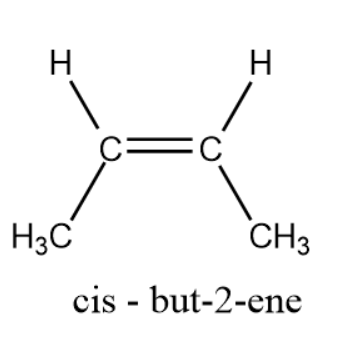
Define isomerism and explain geometrical isomerism in alkene.
Answer
577.2k+ views
Hint: A pair of isomers have the same chemical formula but different chemical structures. Due to change in structures, at times they differ in their properties like boiling point, melting point etc. Geometrical isomerism is the type of isomerism based on the geometry of compounds. One of the types of geometrical isomerism present in alkene is cis-trans form.
Complete step by step answer:
The word “isomer” is derived from the Greek words "isos" and "mers". "Isos" means equal and "mers" means parts, so "isomers" means equal parts.
Isomerism is the phenomenon in which two or more compounds have the same chemical formula but differ in chemical structures. Chemical compounds that have identical chemical formula but differ in properties and the arrangement of atoms in the molecule are called isomers i.e. they exhibit isomerism.
Isomerism is of two types namely, Structural isomerism and stereoisomerism.
In structural isomerism the functional groups and the atoms in the molecules of these isomers are bonded in different ways. Structural isomers have different IUPAC names although their chemical formulae are the same.
The types of structural isomerism are:
- Chain
- Positional
- Functional
- Metamerism
- Tautomerism
- Ring - chain
In stereoisomerism, the compounds have the same chemical formula but differ in their respective orientations of the atoms belonging to the compound in a 3D space.
The types of stereoisomerism are:
- Geometrical
- Optical
Geometrical isomerism is popularly known as cis-trans isomerism.
Geometrical isomers have different spatial arrangements of atoms present in the compound in a 3D space. Given below is an example of pair of isomers exhibiting geometrical isomerism:


Note: In the above section we discussed about cis-trans isomerism. Along with that there are 2 more types of geometrical isomerism:
- syn-anti
- E-Z
Syn-anti nomenclature is used to describe isomerism between carbon and nitrogen double bonds. On the other hand, E-Z nomenclature is used when all the four groups around the double bond are different and we need to decide priority of the attached groups as defined under E-Z nomenclature.
Complete step by step answer:
The word “isomer” is derived from the Greek words "isos" and "mers". "Isos" means equal and "mers" means parts, so "isomers" means equal parts.
Isomerism is the phenomenon in which two or more compounds have the same chemical formula but differ in chemical structures. Chemical compounds that have identical chemical formula but differ in properties and the arrangement of atoms in the molecule are called isomers i.e. they exhibit isomerism.
Isomerism is of two types namely, Structural isomerism and stereoisomerism.
In structural isomerism the functional groups and the atoms in the molecules of these isomers are bonded in different ways. Structural isomers have different IUPAC names although their chemical formulae are the same.
The types of structural isomerism are:
- Chain
- Positional
- Functional
- Metamerism
- Tautomerism
- Ring - chain
In stereoisomerism, the compounds have the same chemical formula but differ in their respective orientations of the atoms belonging to the compound in a 3D space.
The types of stereoisomerism are:
- Geometrical
- Optical
Geometrical isomerism is popularly known as cis-trans isomerism.
Geometrical isomers have different spatial arrangements of atoms present in the compound in a 3D space. Given below is an example of pair of isomers exhibiting geometrical isomerism:


Note: In the above section we discussed about cis-trans isomerism. Along with that there are 2 more types of geometrical isomerism:
- syn-anti
- E-Z
Syn-anti nomenclature is used to describe isomerism between carbon and nitrogen double bonds. On the other hand, E-Z nomenclature is used when all the four groups around the double bond are different and we need to decide priority of the attached groups as defined under E-Z nomenclature.
Recently Updated Pages
Master Class 12 Business Studies: Engaging Questions & Answers for Success

Master Class 12 Economics: Engaging Questions & Answers for Success

Master Class 12 English: Engaging Questions & Answers for Success

Master Class 12 Maths: Engaging Questions & Answers for Success

Master Class 12 Social Science: Engaging Questions & Answers for Success

Master Class 12 Chemistry: Engaging Questions & Answers for Success

Trending doubts
What are the major means of transport Explain each class 12 social science CBSE

Which are the Top 10 Largest Countries of the World?

Draw a labelled sketch of the human eye class 12 physics CBSE

Explain sex determination in humans with line diag class 12 biology CBSE

The pH of the pancreatic juice is A 64 B 86 C 120 D class 12 biology CBSE

Give 10 examples of unisexual and bisexual flowers




